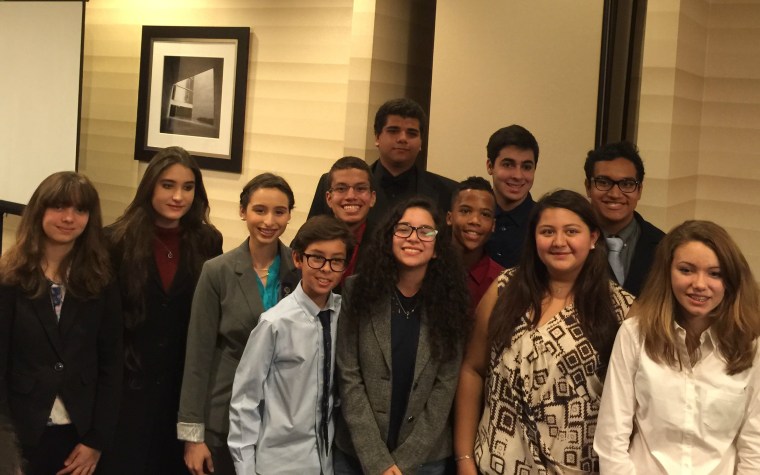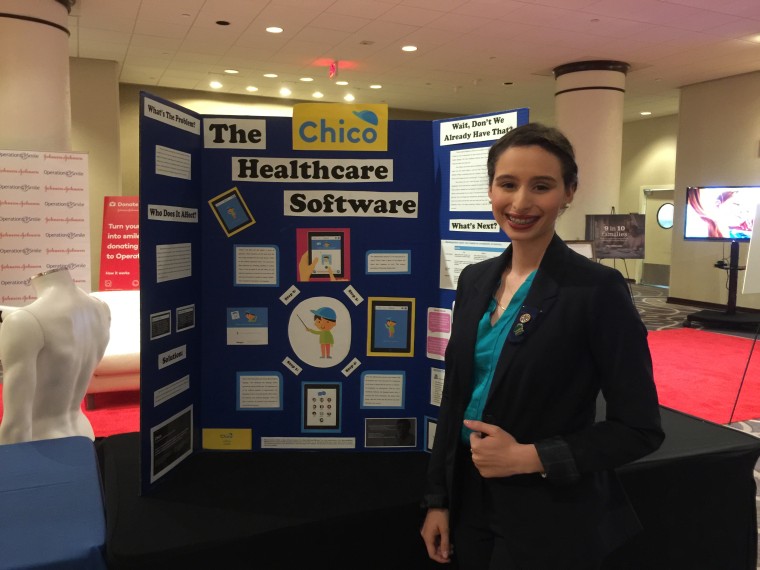Clean energy is a top priority for 13-year-old Julian Martinez.
So, the Florida eighth-grade budding scientist set out to create energy from an affordable and plentiful source - mud. There are bacteria in the mud that create electricity. He experimented by focusing on determining at what temperature the bacteria produce the most electricity, and added an anode and cathode to capture electrical impulses. But the anode and cathode are expensive, so he concluded there needs to be a way to make the energy source cheaper.
Martinez was one of a group of top Latino students from across the country who visited Washington, D.C., last month to showcase their projects in Science, Technology, Engineering, Art, and Math (STEAM) at the Latino Youth Summit during the 2015 LATISM (Latinos in Tech Innovations And Social Media) conference. From robots and cyber security to water purifiers and improved insulation materials, the students had an opportunity to present their projects to White House staff, LATISM conference attendees, and scientists from Mexico.
LATISM founder Ana Roca Castro says she felt compelled to put the summit together after attending the National Science Fair earlier this year. Roca Castro, who is in the technology field as a successful app developer, said she was devastated when she realized not one single Latino student participated. That is when she decided it was time to organize one herself.

Although the number of Latino students graduating with STEM degrees has increased in recent years, they still account for only nine percent of the STEM graduates across the country. Experts agree that part of the reason is a lack of access to resources in high school. According to the Department of Education’s Initiative on Educational Excellence for Hispanics, “Only 67 percent of Hispanic students have access to a full range of STEM courses (Algebra I, Geometry, Algebra II, Calculus, Biology, Chemistry and Physics) in high school.”
The Latino STEAM students proudly displayed and demonstrated their projects at the White House and then at the JW Marriot Hotel on Thursday. Inspired by one of her teachers who was a surfer, 12-year-old Isabela Perdomo focused on creating an energy source using ocean waves. She first developed her project two years ago in fifth grade. But her initial generator had a few design flaws, and she found that she was losing energy when the suction of the waves moving out of the generator wound up reversing the direction of her turbine blades. So it was back to the drawing board.
Perdomo found that by modifying the blades of her turbine, she was able to control the direction of the blades to move in only one direction, thus preventing any loss of energy. Her enthusiasm for her project was evident in her energetic demonstration of her prototype and in the quick, eager way she described her data.
While alternate energy sources were popular, so were tools that benefitted health, such as sophomore Megan Erdozain’s project. She set out to create a more efficient and cheaper prosthetic for a common worker. She replaced the myoelectric sensors typically used with prosthetic arms with less expensive pressure sensors that are more accurate because they eliminate background noise interference and have 100 percent accuracy. Her prosthetic arm cost $250 to build and lifts up to 40 pounds.
Other students included Geraldine Agredo, a 17-year-old from Queens, N.Y. She found her passion in teaching other students at her all-girls’ school how to code. She was inspired after her Spanish teacher Andrea Chaves decided to incorporate coding into her Spanish class, thus teaching the students two languages at a time. Agredo has now helped her classmates learn to create their own websites and video games using student software.
Representing the Arts in STEAM, senior student Shayan Tahmaseb also attended the STEAM fair, his saxophone in hand. He’s the first chair of his high school band in his hometown of Salem, OR., and has been playing the saxophone since the fifth grade. “The arts convey emotions -- feelings -- that science often can’t,” Tahmaseb said. He understands the important link between the arts and STEM subjects because innovation and advances in technology require the creativity nurtured by the arts.

And that creativity and original thinking can be seen in the Latino Youth Summit winner. First Place went to Ashley Chico who created the Chico App, a tool for Emergency Room and other healthcare workers. Basic questions and answers can be uploaded to the app to be translated into multiple languages reducing the need for a professional translator in emergency situations, so people can get urgent care as soon as possible.
The opportunity to share their innovative projects not only affected the students, but their families, too.
“The LATISM inaugural youth STEAM science fair represented for us as parents a symbol of hope for our current and future minority youth,” said Ashley’s parents, Vanessa and Geovanny Chico. “They were able to showcase to fellow Americans that our youth also has the potential to positively impact science, math, technology, engineering and the arts industries, which translates in Latino producing and consuming economic power, and thus contributing to the domestic and international economic growth.”